

EcoKids: Threats to our forests. Deforestation Results of deforestation Forests are cleared all around the world for a number of reasons, including: Harvesting of timber to produce wood and paper products Clearing land for farms, cash-crop plantations, and cattle ranching Clearing land for urban development, including homes and roads.
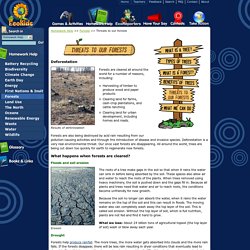
Forests are also being destroyed by acid rain resulting from our pollution-causing activities and through the introduction of disease and invasive species. Deforestation is a very real environmental threat. What happens when forests are cleared? Floods and soil erosion Erosion The roots of a tree make gaps in the soil so that when it rains the water can sink in before being absorbed by the soil. National Geographic: Deforestation. Modern-Day Plague Deforestation is clearing Earth's forests on a massive scale, often resulting in damage to the quality of the land.

Forests still cover about 30 percent of the world’s land area, but swaths the size of Panama are lost each and every year. The world’s rain forests could completely vanish in a hundred years at the current rate of deforestation. Forests are cut down for many reasons, but most of them are related to money or to people’s need to provide for their families.The biggest driver of deforestation is agriculture. Farmers cut forests to provide more room for planting crops or grazing livestock. Logging operations, which provide the world’s wood and paper products, also cut countless trees each year. CBBC Newsround: Amazon deforestation. Some main reasons why areas of rainforests are cut down:Farming e.g. soya fields, cattle ranches Mining Flooding areas of land as part of hydro electric power stations Logging to sell the timber Once the trees go, the soil becomes infertile in one or two years, making it poor for farming.

Hunting becomes more difficult for the people who live there as the habitat for wildlife is lost. Traditional people's cultures are also lost. The effects of deforestation: Trees are removed. Trees do not protect soil so nutrients are washed out by the rain. Soil is now less fertile and the unprotected surface becomes dry and compacted. It is hard for rain to soak into the soil, so flooding may occur. Live Science: Deforestation.
Deforestation is the permanent destruction of forests in order to make the land available for other uses.
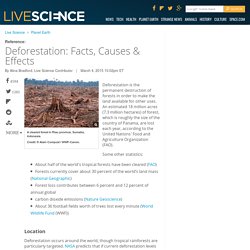
An estimated 18 million acres (7.3 million hectares) of forest, which is roughly the size of the country of Panama, are lost each year, according to the United Nations' Food and Agriculture Organization (FAO). Some other statistics: About half of the world's tropical forests have been cleared (FAO) Forests currently cover about 30 percent of the world’s land mass (National Geographic) Forest loss contributes between 6 percent and 12 percent of annual global carbon dioxide emissions (Nature Geoscience) About 36 football fields worth of trees lost every minute (World Wildlife Fund (WWF)) Deforestation occurs around the world, though tropical rainforests are particularly targeted. NASA predicts that if current deforestation levels proceed, the world's rainforests may be completely in as little as 100 years. Error loading player: No playable sources found Weather vs. Voices of Youth: Deforestation. Member since February 8, 2014 1 Post Deforestation is when humans remove forest areas and the land is turned to something other than a forest.
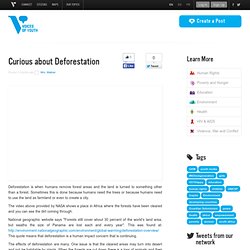
Sometimes this is done because humans need the trees or because humans need to use the land as farmland or even to create a city. The video above provided by NASA shows a place in Africa where the forests have been cleared and you can see the dirt coming through. WWF: Deforestation Main Page. Forests cover 31% of the land area on our planet.
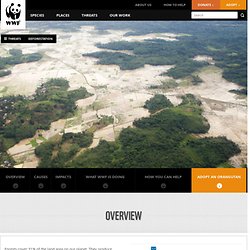
They produce vital oxygen and provide homes for people and wildlife. Many of the world’s most threatened and endangered animals live in forests, and 1.6 billion people rely on benefits forests offer, including food, fresh water, clothing, traditional medicine and shelter. But forests around the world are under threat from deforestation, jeopardizing these benefits. Deforestation comes in many forms, including fires, clear-cutting for agriculture, ranching and development, unsustainable logging for timber, and degradation due to climate change. This impacts people’s livelihoods and threatens a wide range of plant and animal species. Forests play a critical role in mitigating climate change because they act as a carbon sink—soaking up carbon dioxide that would otherwise be free in the atmosphere and contribute to ongoing changes in climate patterns.
WWF: Deforestation. Kids.Mongabay.com: Deforestation. Deforestation refers to the cutting, clearing, and removal of rainforest or related ecosystems into less bio-diverse ecosystems such as pasture, cropland, or plantations (Kricher, 1997).
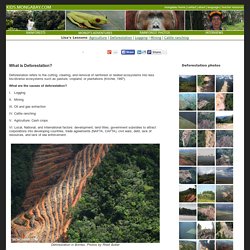
ESchoolToday: Forest Preservation. Introduction to forest preservation Environmental activists consider forests as one of the top 5 natural resources on earth.

This is rightly so, and today, we shall look at how wonderful our forests are to us, and why we should immediately stop its' destruction. There is more to forests than just a massive collection of trees. It is a natural, complex ecosystem, made up of a wide variety of trees, that support a massive range of life forms.